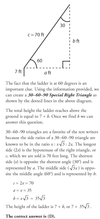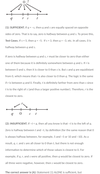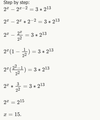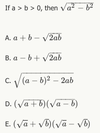Quant Strategy Flashcards
(129 cards)
What do I want to remember when I see a DS formula problem?
Try problem

Always Simplify:
- Question is really asking Does 2m = 3n?

How should you approach the first 30 seconds of every quant problem?
Close your eyes and take a deep breath, then assess:
Understand:
- What type of problem is it (PS, DS)
- What am I being asked for?
- What am I given?
- What can I jot down
Plan:
- Have I seen something like this before?
- What strategy do I want to apply?
- Is there a formula, picture, table that would be helpul?
Solve:
- Keep scratch paper systematic and organized
- Bail (and guess) if you get stuck
How should you address the first 30 seconds of each Problem Solving question?
- Scan the answer choices
- Type?
- Quality
- Symbols
- Spread
- Is the problem Wordy / Math / Geometry?
- Are there content clues?
- Key Words / Terms / Images
- What strategies might work?
- Estimate / Make it real
- Smart #’s / Test Cases / Work Backwards?
- Content specific strategies (build a table, draw a picture)

How should you address the first 30 seconds of each Data Sufficiency question?
- What is tangled?
- Question stem / statements / both?
- Are the statements different or similar?
- Is the problem Wordy / Math / Geometry?
- Are there content clues?
- Key Words / Terms / Images
- What strategies might work?
- Where do you need to rephrase (simplify first)?
- Which statement do you want to start with?

What should I make sure I remember when doing a decimal digits problem?
Try problem.

Make sure your remember to test cases?
Rounded decimals are dependent upon their following number.

What should I make sure I remember if I’m given two formulas, and asked for identify the value of two variables?

Use one formula to solve for the other!!

What should I make sure I remember if asked for distance between tickmarks on a linear scale?

- Redraw the linear line
- Find the LCM
- Identify tickmark values
- Identify distance

What do I want to remember when I see a Mixture problem?

If we’re given two variables that make up a total (e.g. X and Y totaling 300), we can solve for X by applying %’s and backing X out of Y.
- The attached image is the algebra solution, but we can also work backwards!

What’s the first thing I want to remember when I see fractions, within fractions in a denominator?

- Simplify the denominator(s) by consolidating to term!
- e.g. if you have 2 + 1/3 in a demonitaor of a fraction, within another denominator of the fraction, you must first simplify 2+1/3 for 7/3s
- Then repeat this process for as may sub fraction denominators that you have

What do I want to remember when I see a problem with a factorial symbol “!”?

A factorial is the product of all the integers from 1 to to the factorial n. e.g. n! = (1)(2)(3)(4)…(n)
- The sample problem is asking if k has a factor greater than one
- i.e. Is k a prime number or not?
- If K is between 13! +2 and 13! + 13, then it is not prime, as (1)(2)(3)……(13) +2, and (1)(2)(3)….(13) + 13, as 2 would be a factor of 13! +2, and 13 would be a factor of 13! + 13.
- Both of these values are great than 1, which means K is not prime
Whats the first thing I want to identify when I see a probability question?

What is the probability asking for? How can I calculate it?
- With the sample problem, your told that you have 100 balls #’ed 1-100
- The question asks whats the probabilty that the sum of 3 balls pulled will be odd?
- What possible combinations give you and odd sum?
- Odd, Odd, Odd
- Odd, Even, Even,
- Even, Even, Odd
- Even, Odd, Even
- If the balls are numbers 1-100, you have 50 opportunities to pull and odd number and 50 (50/100) = 1/2
- Odd, Odd, Odd = (1/2)(1/2)(1/2) = 1/8
- Odd, Even, Even, = (1/2)(1/2)(1/2) = 1/8
- Even, Even, Odd = (1/2)(1/2)(1/2) = 1/8
- Even, Odd, Even = (1/2)(1/2)(1/2) = 1/8
- The sum of those 4 1/8ths = 4/8ths or 1/2

What is a Units Digit?
Units digit of a number is the digit in the one’s place of the number.
- i.e It is the rightmost digit of the number.
- For example, the units digit of 243 is 3, the units digit of 39 is 9.
What do I want to remember if a statement has variables squared?

Always consider negative #’s.
- If the questions is asking for the value of something, and the statements include #’s squared, remember that even exponents hid the sign of the variable

What’s the the first thing I want to remember when asked for the missing length of the leg of a triangle?

The length of the longest side must be smaller than the sum of the lengths of the two other sides.

What’s the first thing I want to remember when calculating a probability with (an option removed a a coin removed)

The total probability will be the product of the two probabilities
- Calculate the first probability
- In this scenario because the coin is not replaced, it needs to be taken out of both the numerator and denominator in the second calc

What’s the first thing I want to remember when asked for the area of a trapezoid within a Triangle?

- We can back into the area of the triangle, by calculating th encompassing (large triangle) as well as the remaining triangle (when considering whats left after looking at trapezoid)
- If you see || this means the two lines are parallel
- Because they’re parallel you can calculate values for the other subsections using a ratio
- Area of a Triangle = (1/2)bh
- Area of a Trapedoid = h * Avg. of 2 bases (top / bottom)

What’s the first thing I want to remember when considering if question that lists an average within the statment?

Remember that the average will not immediately be negative if there are negative numbers in the data set. The average is the sum / the count.

Whats the first thing I want to remember when I see %’s in the answer choices?

Use Smart #’s to identify the answer
- The answer options include half percents so let’s use 1,000 as a smart # base

Whats the first thing I want to remember when I see a # that is not large enough to be divisible by another number (e.g. 2 divided by 11)?

When a number is not large enough to be divisible by another number, it has a quotient of 0 with a remainder of whatever the number being dived is)

How do I want to set up an algebraic equation for the given word problem?

The ratio of 2 : 23 is given. We’re also told that there are 630 fewer buses than cars.
- As such 2x + 630 = 23x

What do I want to remember when I see variables in the answer choices?

Use Smart #’s!
- Pick a smart number
- Calculate a value using your smart number
- Plug your variable smart number into the answer options.
- The one that results in your hypotherical answer is the choice!

What do I want to remember when I see a right triangle?

- Remember some right triangles have a ratio of 3 - 4 - 5
- Can you back into the lengths of other legs with have these fractions?

What do I want to remember when informed that X is made up of the 2 digit positive integers a + b, and when I’m asked a question about X?

Remember that X is what the questions being asked about, not a + b.
- The second statement says X + 7 is divisible by 9
- DON’T THINK YOU NEED TO CONSIDER Y, Y is not mentioned and X is already inclusive of the 2 variables a + b
- With knowing X + 7 is divisible by 9, you can back into what the remainder of X / 9 would be

What’s the first thing I want to remember when I see this questions?

- What is the question asking?
- Is X Prime
- Statement 2 identifies that X has the same # of factors as Y2 and that Y is a positive integer greater than 2
- If Y is greater than 2 and is squared, it at MINIMUM HAS A FACTOR OF ITSELF!!!
- If Y2 has more than 1 factor, and X has the same # of factors than X cannot be prime!!!!!














































































































































































































